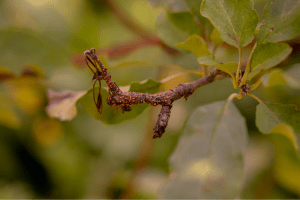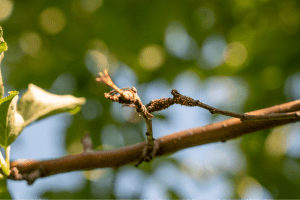What is Nectria Twig Blight and Nectria Canker?
These are two separate diseases caused by two different species of Nectria. Nectria cinnabarinia causes nectria twig blight, while Neonectria galligena causes nectria canker. Of the two, nectria twig blight is generally less common and less agronomically important, only causing significant symptoms in cultivars with large cluster-bud bases (such as Northern Spy). Its symptoms can be confused with Fire Blight (Erwinia amylovora), which makes it critical to identify accurately to prevent a much more serious threat. Nectria canker is present in nearly all apple growing regions and can cause significant orchard damage if untreated. In addition to infecting woody stem tissue, it can also damage fruit as an eye rot on the blossom end of the apple.
What does Nectria look like?
Nectria twig blight will first appear as leaf wilting and eventual death of leaves and infected branches. Cankers cause a girdling effect on infected branches that prevent nutrients and water from effectively moving to those tissues. This symptom can look similar to fire blight, however, it does not show the characteristic shepherd’s crook and is not as aggressive. The cankers are small, sunken, and take years to develop. The twig death effect only occurs once cankers have developed long enough to encircle the twig and cause the girdle effect. Mature cankers may contain sporodochia that range from bright orange to pink.
Nectria canker also starts as cankers on twigs which girdle the tissue, but these cankers are more elliptical and dark red-brown. Most infections occur at leaf scars and pruning cuts, but trunk infections are not uncommon. On older wood (beyond 1 year old growth), zonate cankers may form from dying callous tissue that will display distinct rings from yearly canker growth. Similar to N. cinnabarina, N. diplodia will produce orange perithecia in mature cankers that can release spores for secondary infection. In fruit, the fungus causes an eye rot through the calyx, but infection can also occur through the lenticels and stem cavities.
Where does Nectria Canker and Nectria Twig Blight come from?
The disease cycle of N. cinnabarina is not well known, and controlled infections have been so far fairly unsuccessful. Infection will usually occur in wounded tissue, and frequently invades broken pedicels that remain on the tree after harvest. Established cankers produce ascospores and conidia, which spread to new infection sites by water and wind. The hyphae produced by these spores block xylem tissue, and kill the branch by blocking the flow of water and nutrients.
N. galligena can also spread from tree to tree by water (macroconidia) and wind (ascospores). Infection begins in the autumn on leaf scars following leaf drop and pruning cuts, however symptoms will not develop until the following spring. During an outbreak, the wind spread ascospores are primarily starting new infections on neighboring trees, while the water spread conidia are amplifying the disease within the tissue of already infected individuals. Infection severity is controlled primarily by wet weather, and longer wet periods lead to a higher incidence of cankers. Wounds decrease in infection susceptibility the longer they have to heal, so the weather conditions surrounding leaf drop in autumn are critical for assessing likely disease pressure during the next growing season. Although it is most prevalent in the fall, it is important to note that infection can occur year round and it is still recommended that you plan pruning around the weather forecast to prevent mid-season flare ups.
How do I prevent and control Nectria Twig Blight and Canker?
For Twig Blight:
- Keep plants healthy and avoid abiotic stresses to prevent susceptibility to infection
- When harvesting fruit, make sure to remove the fruit stem from the tree to avoid the wounds that twig blight attacks
- Prune woody tissue during the winter that shows sporodochia spore growth
For Nectria Canker:
- Protectant fungicide applications in the spring and early summer can help reduce sporulation and protect trees against new infection
- Fungicide applications in the fall during and after leaf fall help prevent new infections from developing on the injured tissue
- Remove limbs with developed cankers, and treat wounds to the tree with a canker paint to prevent infection

